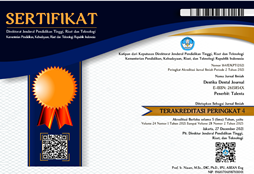ANALYSIS OF ROOT CANAL MORPHOLOGY OF INCISOR TEETH USING PERIAPICAL RADIOGRAPHY BISECTING TECHNIQUE AND CHANGE HORIZONTAL ANGULATION 30º IN SUB RACE PROTO AND DEUTRO MALAY
ANALISIS MORFOLOGI SALURAN AKAR GIGI INSISIVUS MENGGUNAKAN RADIOGRAFI PERIAPIKAL TEKNIK BISEKTRIS DAN PERUBAHAN ANGULASI HORIZONTAL 30º PADA SUB RAS PROTO DAN DEUTRO – MELAYU
DOI:
https://doi.org/10.32734/dentika.v21i01.1107Keywords:
root canal, incisors, periapical radiography, horizontal angulationAbstract
The incisor has a variation of root canal morphology, which can be assessed using periapical radiography. Periapical radiography with standard angulation often makes complicates the assessment of the root canal morphology that is branched off in buccal and lingual directions because the radiograph result of the root canal will appear superimposed. Therefore, it is necessary to change horizontal angulation to mesial or distal to help assess the superimposed root canal. Root canal morphology may vary by population. The population in Indonesia consists mainly of the sub-races of Proto and Deutro-Malay. The purpose of this study was to determine the difference of root canal morphology between maxillary and mandibular incisors; between the sub-races of Proto and Deutro-Malay; and between the right and left regions, using twice the radiation projection. This study was an analytical study with cross-sectional method using 55 subjects who come from three previous generations of Proto and Deutro-Malay. On each tooth were performed twice radiations periapical radiography, using standard angulation and altering horizontal angulation toward distal 30º. The results showed that in Proto-Melayu, for maxillary central incisors maxillary teeth were obtained type I (99.1%) and III (0.9%) Vertucci, and maxillary lateral incisors were obtained type I Vertucci (100%). In mandibular central incisors were obtained type I (90%), II (3.6%), III (2.7%) Vertucci and IV Gulabivala (3.6%), and mandibular lateral incisors were obtained type I (87.3 %), II (1.8%), III (7.3%) Vertucci and type IV Gulabivala (3.6%). In Deutro-Malay, maxillary central incisors were obtained 100% Vertucci type I and maxillary lateral incisors were obtained type I (99.1%) and II (0.9%). In mandibular central incisors were obtained type I (85.5%), III (11.8%) Vertucci, IV Gulabivala (1.8%), and other types 1-2-1-2-1 (0.9%), and mandibular lateral incisors were obtained by type I (81.8%) and III (18.2%) Vertucci. The result of chi-square analysis showed there were no significant differences of root canal morphology of maxillary insicors tooth between Proto and Deutro-Malay and between right and left region (p> 0,05), but there were significant differences of root canal morphology between maxillary and mandibular incisors and root canal morphology of the mandibular incisor between Proto and Deutro-Malay (p <0.05). In conclusion, maxillary and mandibular incisors of Proto and Deutro-Malay sub-races have variations in root canal configuration and there were differences found in the mandibular incisors.


















